前面讲了,这一节发个与佛教有关的卍字图。这个图形应该是我上学时课桌上刻的最多的三个符号之一,另外两个是"早"和五角星。卍梵文Svastika,武则天定音为万字;意译为吉祥海云,吉祥喜旋,为佛三十二相之一,也是八十种好之一;此为显现于佛及十地菩萨胸臆等处之德相。长阿含经卷一大本经、大萨遮尼乾子所说经卷六、大般若经卷三八一等均记载佛之胸前、手足、腰间等处有卍字。于今印度阿摩罗婆提(Ama-ravati)出土之佛足石,亦刻有数个卍字。纳粹德国的纳粹党标志为希特勒借用的标致,但纳粹党标志的方向是斜的和黑色,而传统信仰中代表吉祥美好的卍字符多是明亮的色彩。
佛教传入华夏大地,卍和卐也便传到了中国,并且卍和卐也融入中华文化之中,从那以后汉字中有了卐合卍。其实这个卐合卍是一个字”万“而且是对称的,卐是右旋(代表胸前十字向自己右手旋转),卍为左旋(代表胸前的十字向自己左手旋转)。
对于生成卍字的算法,比起要容易得多,整体思路是创建一个大个矩形,再用四个小矩形将其不需要的地方扣去。代码如下:
1 struct Rect 2 { 3 float left; 4 float right; 5 float top; 6 float bottom; 7 }; 8 9 inline bool IsInRect(const Rect& rect, float x, float y)10 {11 return (x >= rect.left && x <= rect.right && y >= rect.top && y <= rect.bottom);12 }13 14 unsigned int CPixelSvastikaLeft::CalculatePixel(unsigned int x, unsigned int y)15 {16 float size = m_params[0];17 float width = m_params[1];18 float angle = m_params[2]*PI/180;19 20 unsigned int black = 0xff000000;21 unsigned int gray = 0xff808080;22 23 float i = x - 512.0f;24 float j = y - 512.0f;25 26 Rect rect = {-size, size, -size, size};27 Rect rtLeft = {-size, -width*0.5f, -size + width, -width*0.5f};28 Rect rtTop = {width*0.5f, size - width, -size, -width*0.5f};29 Rect rtRight = {width*0.5f, size, width*0.5f, size - width};30 Rect rtDown = {-size + width, -width*0.5f, width*0.5f, size};31 32 float _s = sinf(angle);33 float _c = cosf(angle);34 float ti, tj;35 36 ti = i*_c - j*_s;37 tj = i*_s + j*_c;38 39 if (!IsInRect(rect, ti, tj))40 {41 return gray;42 }43 else if (IsInRect(rtLeft, ti, tj) ||44 IsInRect(rtTop, ti, tj) ||45 IsInRect(rtRight, ti, tj) ||46 IsInRect(rtDown, ti, tj))47 {48 return gray;49 }50 51 return black;52 } 
另一个方向的卐字,只需要对上面代码做如下改动:
Rect rtLeft = {-size, -width*0.5f, width*0.5f, size - width}; Rect rtTop = {-size + width, -width*0.5f, -size, -width*0.5f}; Rect rtRight = {width*0.5f, size, -size + width, -width*0.5f}; Rect rtDown = {width*0.5f, size - width, width*0.5f, size}; 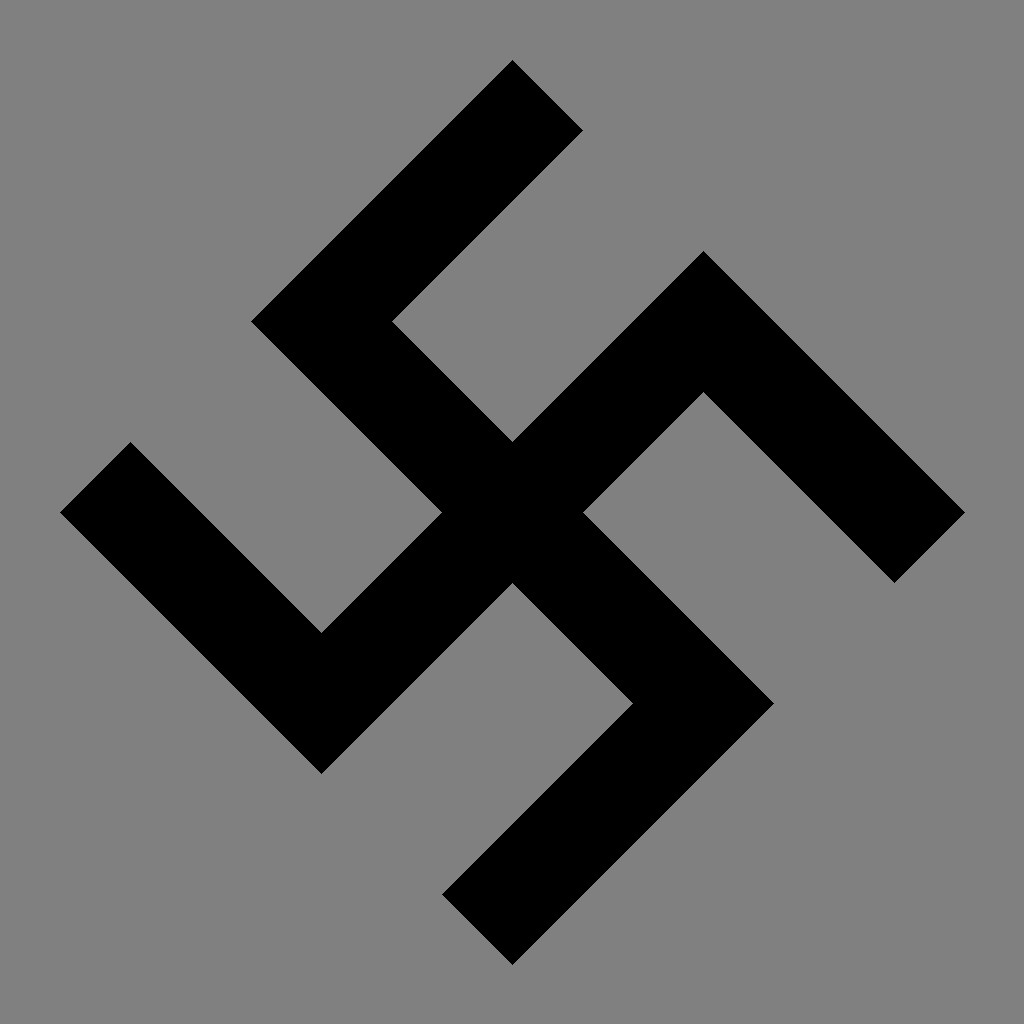
相应软件:,在软件中可以调节卍字的宽度和旋转,如下图所示:
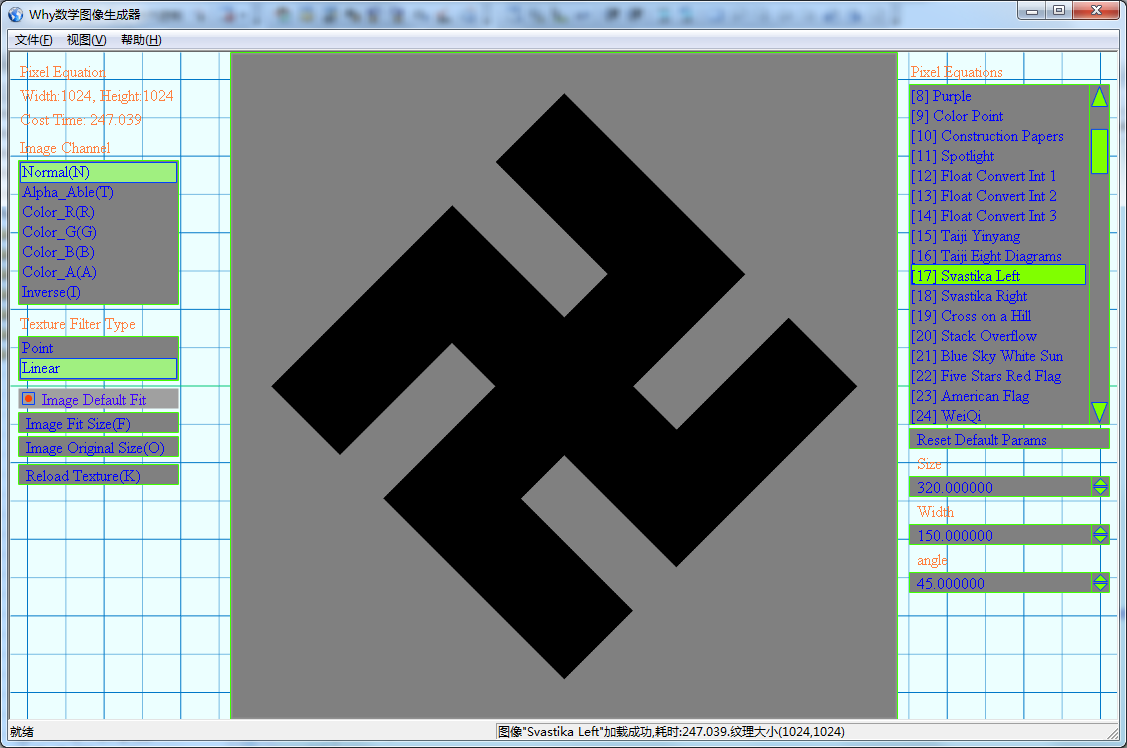
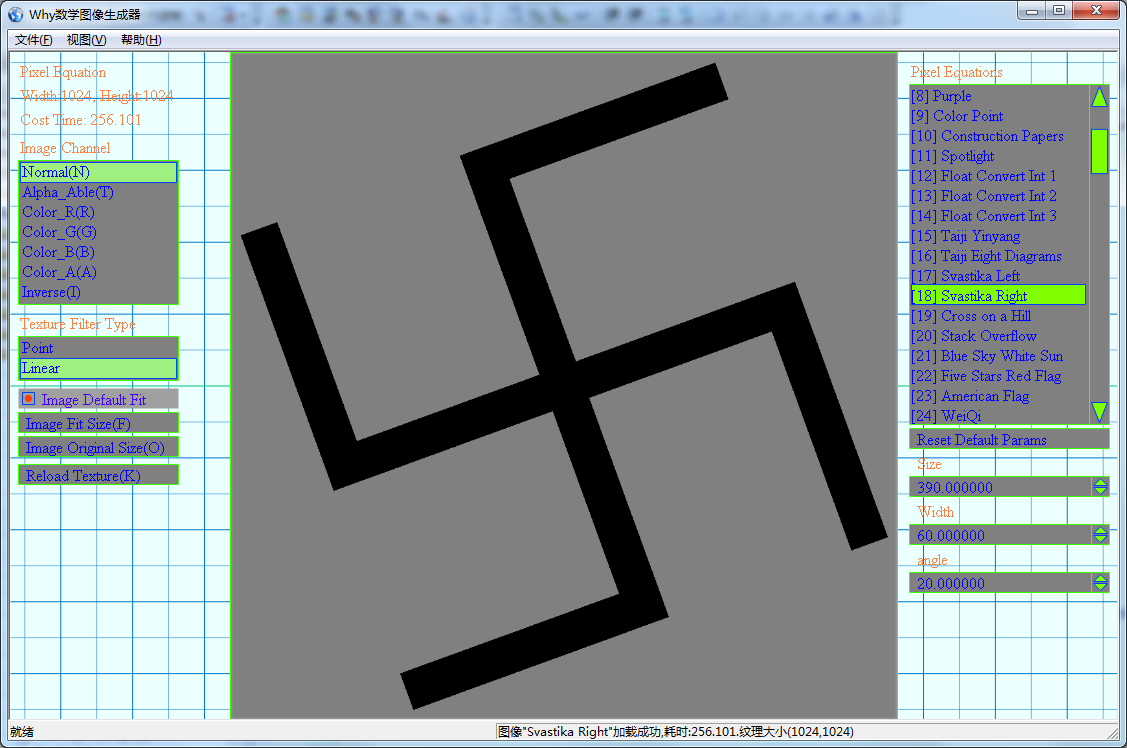
在古典家具中,经常会看到卐和卍字,如窗户上.下面,我将卐卍连起来,画出分形的图像来:
unsigned int CPixelSvastikasSet::CalculatePixel(unsigned int x, unsigned int y){ const unsigned int size = 64; float width = m_params[0]; unsigned int color = 0xffffe020; unsigned int gray = 0xff808080; int index = x/size + y/size; x %= size; y %= size; float half_size = size*0.5f; float i = x - half_size; float j = y - half_size; Rect rt1 = {-width*0.5f, width*0.5f, -half_size + width, half_size - width}; Rect rt2 = {-half_size + width, half_size - width, -width*0.5f, width*0.5f}; Rect rt3 = {-half_size + width, -half_size + 2*width, -half_size, -width*0.5f}; Rect rt4 = {width*0.5f, half_size, -half_size + width, -half_size + 2*width}; Rect rt5 = {half_size - 2*width, half_size - width, width*0.5f, half_size}; Rect rt6 = {-half_size, -width*0.5f, half_size - 2*width, half_size - width}; Rect rt7 = {-half_size + width, -half_size + 2*width, width*0.5f, half_size}; Rect rt8 = {width*0.5f, half_size, half_size - 2*width, half_size - width}; Rect rt9 = {half_size - 2*width, half_size - width, -half_size, -width*0.5f}; Rect rt10 = {-half_size, -width*0.5f, -half_size + width, -half_size + 2*width}; if (IsInRect(rt1, i, j) || IsInRect(rt2, i, j)) { return color; } else { if (index & 1) { if (IsInRect(rt3, i, j) || IsInRect(rt4, i, j) || IsInRect(rt5, i, j) || IsInRect(rt6, i, j)) { return color; } } else { if (IsInRect(rt7, i, j) || IsInRect(rt8, i, j) || IsInRect(rt9, i, j) || IsInRect(rt10, i, j)) { return color; } } } return gray;} 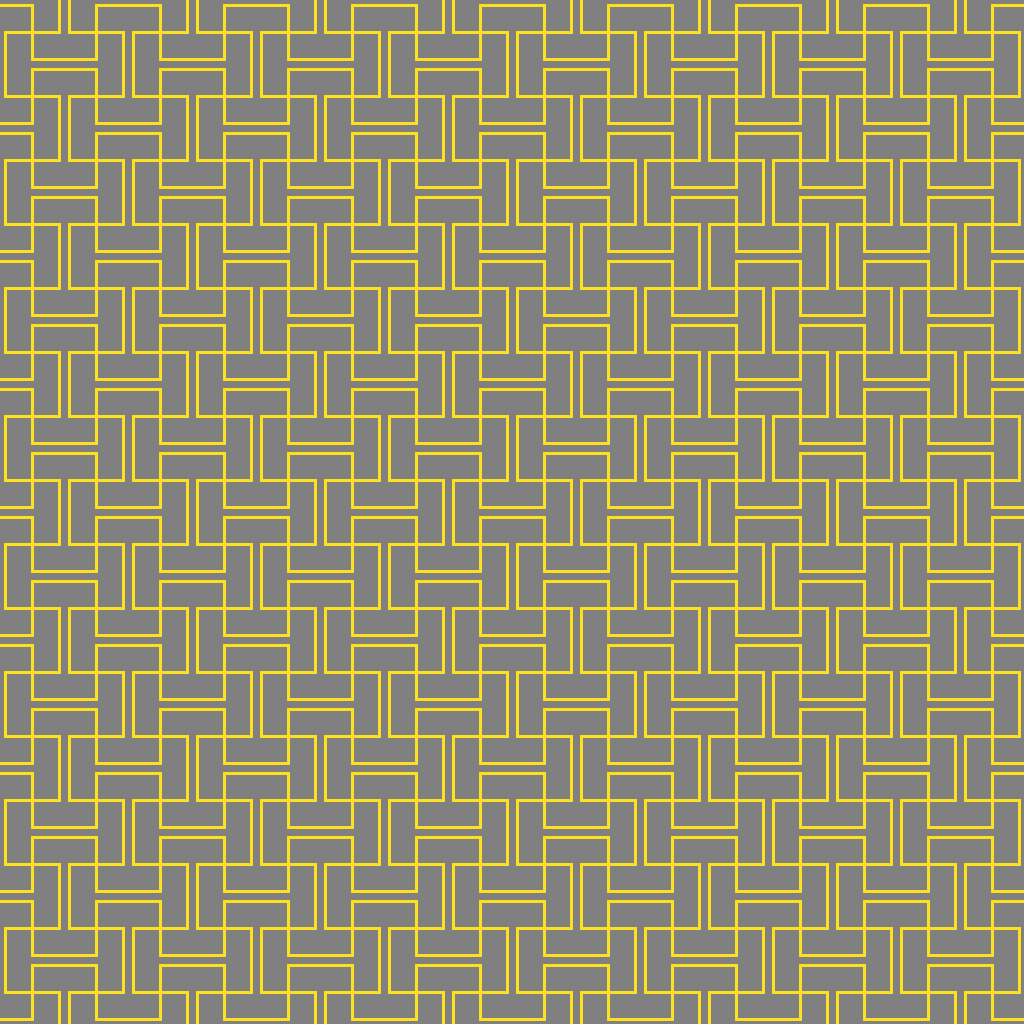
在我的软件中,用户可以调节其宽度:
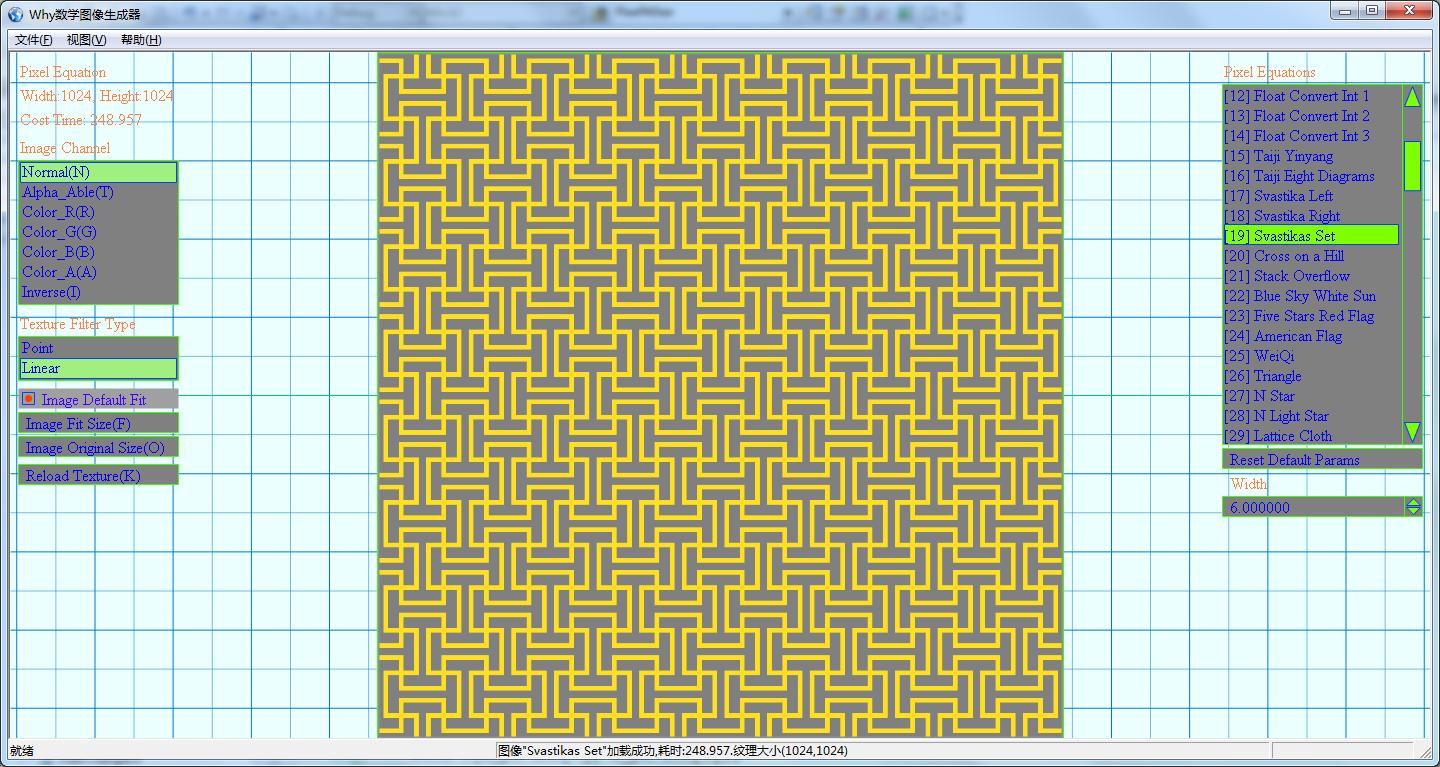
相关文章: